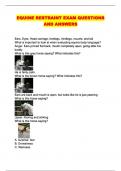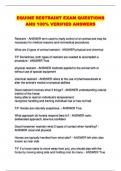Equine restraint exam - Study guides, Class notes & Summaries
Looking for the best study guides, study notes and summaries about Equine restraint exam? On this page you'll find 16 study documents about Equine restraint exam.
All 16 results
Sort by
EQUINE RESTRAINT EXAM QUESTIONS AND ANSWERS...
EQUINE RESTRAINT EXAM QUESTIONS AND 100% VERIFIED ANSWERS...
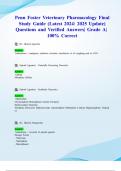
-
Penn Foster Veterinary Pharmacology Final Study Guide (Latest 2024/ 2025 Update) Questions and Verified Answers| Grade A| 100% Correct
- Exam (elaborations) • 61 pages • 2024
- Available in package deal
-
- $11.49
- + learn more
Penn Foster VET 124 Final Exam Penn Foster Veterinary Pharmacology Final Study Guide (Latest 2024/ 2025 Update) Questions and Verified Answers| Grade A| 100% Correct Q: Rx: Opioid Agonists Answer: Indications = analgesia, sedation, restraint, anesthesia, tx of coughing and tx of D+ Q: Opioid Agonists - Naturally Occurring Narcotics Answer: Opium Morphine Sulfate Q: Opioid Agonists - Synthetic Narcotics Answer: Meperidine Oxymorphone Butorphanol tartrate Fentanyl H...
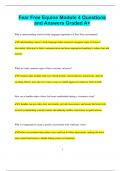
-
Fear Free Equine Module 4 Questions and Answers Graded A+
- Exam (elaborations) • 9 pages • 2024
- Available in package deal
-
- $9.99
- + learn more
Fear Free Equine Module 4 Questions and Answers Graded A+ Why is understanding a horse's body language important in a Fear Free environment? Understanding a horse’s body language helps caregivers recognize signs of stress or discomfort, allowing for better communication and more appropriate handling to reduce fear and anxiety. What are some common signs of fear or anxiety in horses? Common signs include wide eyes, flared nostrils, tensed muscles, pinned ears, and tail swishing...
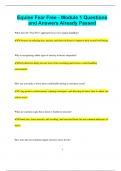
-
Equine Fear Free - Module 1 Questions and Answers Already Passed
- Exam (elaborations) • 8 pages • 2024
- Available in package deal
-
- $9.99
- + learn more
Equine Fear Free - Module 1 Questions and Answers Already Passed What does the "Fear Free" approach focus on in equine handling? It focuses on reducing fear, anxiety, and stress in horses to improve their overall well-being. Why is recognizing subtle signs of anxiety in horses important? Early detection helps prevent stress from escalating and ensures a safer handling environment. How can you make a horse more comfortable during a veterinary exam? Using positive reinforceme...
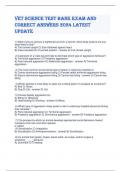
-
Vet Science Test Bank exam and correct answers 2024 latest update
- Exam (elaborations) • 39 pages • 2024
-
- $15.49
- + learn more
Vet Science Test Bank exam and correct answers 2024 latest update 1) When trying to remove a frightened cat from a kennel, which body posture are you least likely to see? A) Tail carried upright C) Ears flattened against head B) Paws elevated D) Crouched position - answer A) Tail carried upright 2) Castration of a male dog will help to eliminate which type of aggressive behavior? A) Territorial aggression C) Predatory aggression B) Fear-induced aggression D) Redirected aggression - ...
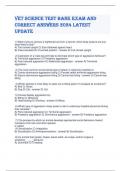
-
Vet Science Test Bank exam and correct answers 2024 latest update
- Exam (elaborations) • 39 pages • 2024
-
- $15.99
- + learn more
Vet Science Test Bank exam and correct answers 2024 latest update 1) When trying to remove a frightened cat from a kennel, which body posture are you least likely to see? A) Tail carried upright C) Ears flattened against head B) Paws elevated D) Crouched position - answer A) Tail carried upright 2) Castration of a male dog will help to eliminate which type of aggressive behavior? A) Territorial aggression C) Predatory aggression B) Fear-induced aggression D) Redirected aggression - ...
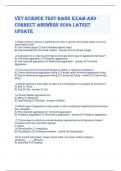
-
Vet Science Test Bank exam and correct answers 2024 latest update
- Exam (elaborations) • 39 pages • 2024
-
- $16.99
- + learn more
Vet Science Test Bank exam and correct answers 2024 latest update 1) When trying to remove a frightened cat from a kennel, which body posture are you least likely to see? A) Tail carried upright C) Ears flattened against head B) Paws elevated D) Crouched position - answer A) Tail carried upright 2) Castration of a male dog will help to eliminate which type of aggressive behavior? A) Territorial aggression C) Predatory aggression B) Fear-induced aggression D) Redirected aggression - ...
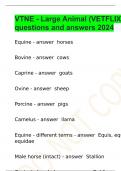
-
VTNE - Large Animal (VETFLIX) exam questions and answers 2024
- Exam (elaborations) • 6 pages • 2024
-
- $12.99
- + learn more
Equine horses Bovine cows Caprine goats Ovine sheep Porcine pigs Camelus llama Equine - different terms Equis, equid, equidae Male horse (intact) Stallion Castrated male horse Gelding Female horse Mare Young Female horse Filly Young Male horse Colt Gestation in horses 11 months 11 days (320-370 days) Horses behavior fight or flight animals What body part do you watch on horses to read ...
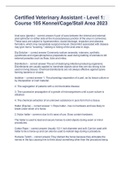
-
Certified Veterinary Assistant - Level 1: Course 105 Kennel/Cage/Stall Area 2023
- Exam (elaborations) • 6 pages • 2023
- Available in package deal
-
- $10.49
- + learn more
Certified Veterinary Assistant - Level 1: Course 105 Kennel/Cage/Stall Area 2023Anal sacs (glands) A pair of sacs between the internal and external anal sphincter on either side at the mucocutaneous junction of the anus in carnivores. These sacs are subject to hypersecretion, ductal blockage, impaction and abscess formation, which may necessitate surgical removal. Discomfort associated with disease may give rise to "scooting," rubbing or licking of the anal area in dogs. Dip Solution ...

Do you wonder why so many students wear nice clothes, have money to spare and enjoy tons of free time? Well, they sell on Stuvia! Imagine your study notes being downloaded a dozen times for $15 each. Every. Single. Day. Discover all about earning on Stuvia

